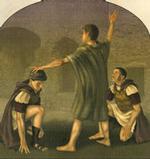Raffaella ballet premiere: love opening the way to artistic greatness
By Thomas V. Mirus ( bio - articles - email ) | Jul 09, 2024
At the end of June, I traveled to South Bend, Indiana, to witness what will likely have been this year’s most significant Catholic arts event: the premiere of Raffaella, a new full-length classical ballet commissioned, written, composed, choreographed, and set-designed by Catholics.
In a time where there is more academic discussion of beauty in the Church than there is consistent production of it, this ballet proves what Catholics are capable of when we believe that artistic greatness is still possible if they embrace their God-given gifts—and that it still matters enough to justify the bold outlay of time, training, and money.
Indeed, this production sets a high mark for artistic ambition also outside the Catholic world, as it is rare for the even prestigious ballet companies to create new full-length works. When producer Duncan Stroik was told by those in the know that “nobody does that anymore,” he told me in our interview, he responded, “Oh—well, then I’d better do it.”
This ambition was born of love. Duncan’s daughter, Raffaella Maria Stroik, was a dancer with the St. Louis Ballet. In 2018, considering a possible vocation to the religious life and feeling the need for a day of recollection, she went on a hike near a lake, where, apparently due to a freak snowstorm with low visibility, she tragically drowned. Raffaella’s parents, Duncan and Ruth, seeking a way to memorialize their daughter, settled on the idea of commissioning a new ballet in the style she loved.
The story, written by the Stroiks, is a fairy-tale inspired by Raffaella’s life, set in the fictional 18th-century Italian village of San Michele. Raffaella’s birth, baptism, and first communion are marked by a prophecy of greatness, the presence of archangels, and above all, a mysterious Prince clad in white. The core of the story is Raffaella’s developing relationship with this Prince, who appears intermittently as her dance partner as she pursues a life dedicated to beauty, not only the beauty of ballet but the spiritual beauty of interior freedom and charity. The second act takes Raffaella to Rome, where she studies dance and is tempted by another prince who offers her a crown, but who is revealed as demonic in nature when she refuses his blandishments. Finally, Raffaella returns to the lake near her home village, where the true Prince appears once more, and invites her to depart with him for his kingdom.
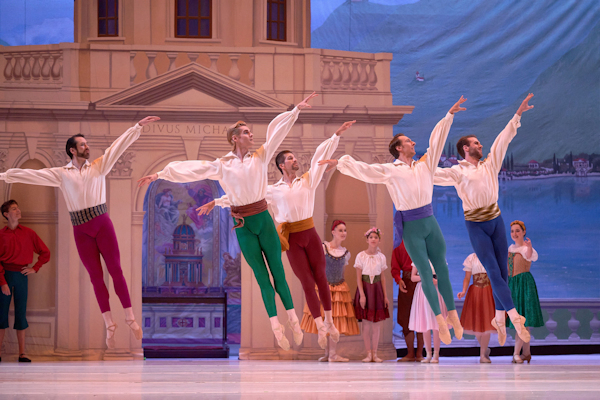
Raffaella runs about seventy minutes (not counting intermission), a length which both allows and requires some variety of scenario. The Stroiks plotted the ballet in such a way that it has something for everyone: lighthearted village dances, romantic duets, spiritual dance-combat between angels and devils, and even a swordfight. There are also a few purely dramatic sequences without dancing.
These all take place within sets designed by architect Gabriella Stroik Johnson (Raffaella’s sister), whose work lends an impressive monumental verisimilitude to the Italian setting. Most striking is the visual center of the San Michele set, a church with an open door revealing the tabernacle inside. Aside from providing the ballet with its most explicit Catholic imagery, when characters enter the church, it provides a space for stillness and interiority in an otherwise mobile art form.
Composer Michael Kurek’s style has been described as neo-romantic; his music for Raffaella may remind the listener of a classic orchestral film score. It has thematic consistency without becoming too repetitive, flows well with the dance, and enhances the story’s emotional beats. Important spiritual moments are signified by the adaptation of Latin hymn melodies (Salve regina and Tantum ergo). For variety, I particularly enjoyed Kurek’s pieces for the Roman ballet school sequence, in which the lush orchestration is stripped down to something closer to a chamber group. The sequence begins with a playful-pedagogical celesta solo, evoking a typical ballet class which is accompanied by a single musician rather than a full orchestra.
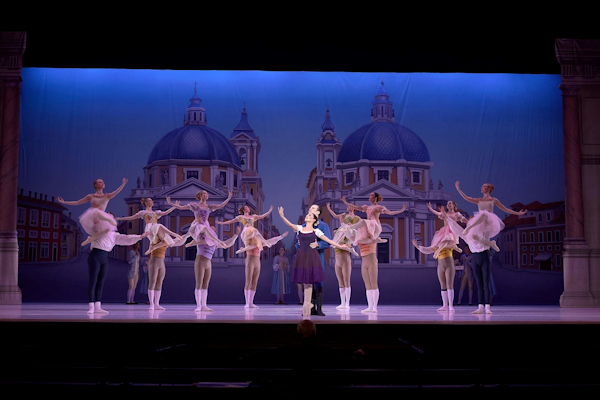
Raffaella is a milestone for choreographer Claire Kretzschmar. Having retired in 2022 after twelve years dancing with the New York City Ballet, she is transitioning into a career of choreography and teaching. This year she also became the artistic director of Ballet Hartford in Connecticut, but Raffaella is by far the largest work she has taken on.
In her past work Kretzschmar has shown herself versatile in crafting solos, pas-de-deux (duets), and larger ensembles. Above all, I have observed in her style a precise musical sensitivity and a certain memorable clarity or legibility in the arrangement of groups. This last trait is especially crucial for this ballet, which has a cast of almost fifty, with many scenes that in less skilled hands could easily have become overcrowded. In Raffaella, there are of course many details only to be observed on repeat viewing—fortunately I was able to attend both performances—but the essential action is both aesthetically and narratively clear. This is of course a tribute to the cast as well; it all came together remarkably well considering that these dancers, who were assembled from all over the country, only had six weeks to rehearse.
Raffaella is also Kretzschmar’s first narrative ballet. This requires another vocabulary in addition to that of dance, namely pantomime, to communicate plot-specific actions, emotion, and even conversation without words. Here again, there is a clarity of narrative and spiritual symbolism, especially in the ballet’s stunning final sequence, which I will dwell on a bit here.
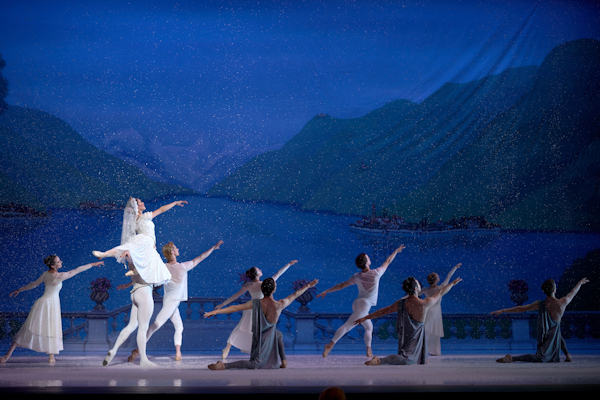
After escaping the false prince, Raffaella has returned to her home, but quickly realizes that neither her old life nor her many suitors can satisfy her. As it begins to snow, she goes to the lake alone to reflect, and many figures from her past reappear in her memory. The true Prince makes a final appearance, offering to crown Raffaella and take her to his mountain kingdom.
I was not the only audience member who immediately responded with tears when the snow began to fall at the beginning of this sequence—before any character had walked on stage. That is to say that I find it impossible to separate my emotional response to this work from my knowledge of the real-life events. At first, I attempted to do so for the sake of some kind of artistic objectivity, but this was misguided because Raffaella is a particular kind of art: a memorial, a story intended to be considered in light of the real Raffaella (and vice versa), just as much as a statue would be. As a good fairy-tale should, the piece works with a broad and primordial array of human experience and aspiration, and thus it will appeal to those who don’t know the backstory. Still, the ballet was made for this occasion, for this community who knew Raffaella.
In this final sequence there re-emerges the perspective of the bereaved parents, who meet their baby at the beginning of the ballet and say goodbye to her in its final moments. Here is where the clarity of body language is most poignant. Through gesture alone, we see Raffaella explaining to her parents that she is leaving with the Prince. Again, the emotional impact was for me compounded by the awareness that in real life, the parents did not get to say goodbye in this literal sense—and yet (if I can dare to speak of an experience I scarcely comprehend), rather than being mere wish-fulfillment, the balletic goodbye is symbolically true and offers a very particular and hard-earned spiritual insight.
Raffaella turns to the Prince and asks if her parents can come with her. He gestures a firm no, at which point the real parting begins. In a moment that defined the ballet for me, as Raffaella embraces her parents, the trio is for a moment surrounded by swirling devils. The temptation is for the parents to rebel, to hold on to their daughter. But they do not.
Kurek’s music powerfully captures the push and pull of Raffaella’s memory, will, and emotions between the majesty of her destiny and the sorrow of her loss. Finally, there is an orchestral shout of victory as Raffaella, held aloft by the Prince, is carried slowly in the direction of the mountains across the lake, as the curtain falls. For days after the final performance, this music returned to my inner ear as I went to bed, immediately summoning all the bittersweet emotion of the finale.
As another layer, knowing that Raffaella was considering a religious vocation, the final moments made me think not only of bodily death, but of religious life as a total surrender to Christ’s courtship of the soul, and of taking vows as death to the world. This kind of goodbye, and this temptation for the parents of the bride of Christ, is surely as old as the religious life itself. One’s reading of Raffaella need not be bound exclusively to the real-life events; rather, the universal beauty and significance of a young woman’s life are unlocked when that life is poetically transformed into a fairy story with timeless symbols.
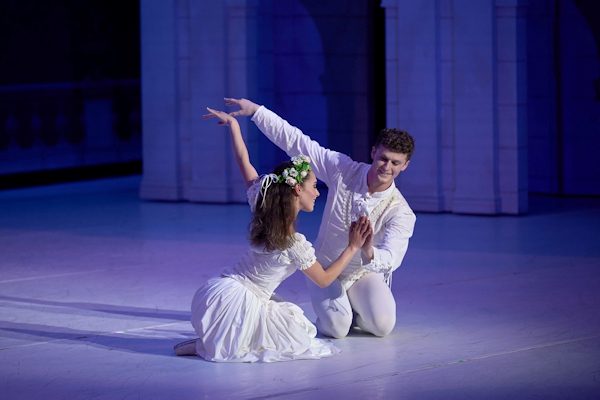
I have great admiration for these parents who entered into the artistic dreams of their daughter so deeply that they were able themselves to produce a fitting tribute in her chosen art form. It’s notable that the idea did not come from professional ballet people, though Duncan and Ruth Stroik are artists in other forms (architecture and painting respectively). They knew the ballet well enough to have a sense of quality as well as of Raffaella’s particular tastes, but ultimately they relied on expertise of professionals, in a symbiotic relationship of good artistic values that one wishes were more characteristic of modern patronage.
To that same point, I can’t conclude without noting that Raffaella was to a large extent crowdfunded. The donors’ motivation was not merely art for art’s sake—this was, rightly, a community coming together to pay tribute to the ideals and virtues of a beloved young woman. Aside from the specific impetus, the success of this project proves that art patronage on a large scale is still possible within the Church. Willingness to take risks is necessary, but where there is vision combined with confidence in God—a confidence above all instilled by parents who encourage their children to follow their dreams—the means will follow. We hope it need not always take a tragedy to induce others to follow suit.
All comments are moderated. To lighten our editing burden, only current donors are allowed to Sound Off. If you are a current donor, log in to see the comment form; otherwise please support our work, and Sound Off!
-
Posted by: Katherine01 -
Jul. 23, 2024 1:04 AM ET USA
Beautiful. Thank you for sharing your experience watching Raffaella. Had read of its creation, creators, subject, and hopes. Shared its crowdfunding story! Cheers and applause and tears all sound quite fitting for something this new, sad, joyful, and again - beautiful. Thank you!!!





